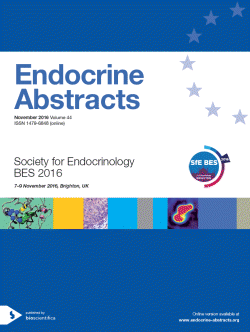
Society for Endocrinology BES 2016
Brighton,
UK
07 Nov 2016 - 09 Nov 2016

Poster Presentations
Clinical biochemistry
ea0044p62 | Clinical biochemistry | SFEBES2016
Burden of major sodium and calcium abnormalities in the non-ITU adult inpatient population of a large two-site university hospital
Jones Philip , Mamoojee Yaasir , Neely Dermot , Quinton Richard
ea0044p63 | Clinical biochemistry | SFEBES2016
Pheochromocytoma and Paraganglioma audit
Ravindran Ravikumar , Dacruz Thomas , Rees Aled
ea0044p64 | Clinical biochemistry | SFEBES2016
Management of hyponatraemia in acute hospital admissions: Effect on length of stay, readmission and mortality
Sharma Aditi , Avari Parizad , Singh Jasmeet , Anyasodor Monica , Ostberg Julia E. , Devendra Senan
ea0044p65 | Clinical biochemistry | SFEBES2016
Osteoporosis and low-dose prednisolone: Is there a link? Insights from bone turnover markers
Ang Yvette , Leckey Adam , Choudhury Sirazum , Courtney Alan , Tan Tricia , Meeran Karim
ea0044p66 | Clinical biochemistry | SFEBES2016
Audit of plasma catecholamines vs. plasma metanephrines: experience at a tertiary endocrine referral centre
Taylor David R , Alexander Alex , Schweitzer Adam , Stone Colin , Whitelaw Ben , Aylwin Simon , Vincent Royce P
ea0044p67 | Clinical biochemistry | SFEBES2016
Three minute run time LC-MS/MS method for separation and quantifying 25-hydroxyvitamin D from C3-epimers
Jenkinson Carl , Bradbury James , Taylor Angela , He Shan , Viant Mark , Hewison Martin
ea0044p68 | Clinical biochemistry | SFEBES2016
An audit of the acute investigation and management of hyponatraemia in a hospital population
Hutchinson Kate , Sivapackianatham Rasheeta , Gelding Susan , Siddiqi Ahmed
ea0044p69 | Clinical biochemistry | SFEBES2016
Evaluating the feasibility of using simulation to teach junior doctors the management of endocrine emergencies
Hutchinson Kate , Gunganah Kirun , Ladwa Meera , Gelding Susan
ea0044p70 | Clinical biochemistry | SFEBES2016
Red blood cell folate vs serum folate: Which one to measure?
ea0044p71 | Clinical biochemistry | SFEBES2016
Evaluation of diagnostic cut-offs for aldosterone-renin ratio using iSYS assays for aldosterone and direct renin
Fairclough Charlotte , Milan Anna , Phillips Suzannah
ea0044p72 | Clinical biochemistry | SFEBES2016
Changes in serum 25-hydroxyvitamin D, 24,25-dihydroxyvitamin D and 1,25-dihydroxyvitamin D in response to three vitamin D3 supplementation regimens
Tang Jonathan , Nicholls Holly , Dutton John , Piec Isabelle , Washbourne Christopher , Saleh Lanja , Novak A , Close Graeme , Macdonald Helen , Fraser William
ea0044p73 | Clinical biochemistry | SFEBES2016
Investigations and management of hyponatraemia: experience at a district general hospital
Tauni Rahat Ali , Omer Tahir , Khan Mustafa
ea0044p74 | Clinical biochemistry | SFEBES2016
Characterising susceptibility to heat illness by plasma copeptin measurement
Stacey Mike , Delves Simon , Woods David , Britland Sophie , Fallowfield Joanne , Allsopp Adrian , Brett Stephen
ea0044p75 | Clinical biochemistry | SFEBES2016
A case series of sodium glucose co-transporter-2 inhibitor (SGLT-2i) related diabetic ketoacidosis and literature review of the possible pathophysiology
Bashir Jawad , Bain Steve , Khan Irfan , Saeed Tamar
ea0044p76 | Clinical biochemistry | SFEBES2016
Time taken for GH-treated adolescent patients, transitioning to adult services, to reach IGF1 levels within the upper normal range: Do we need to monitor more frequently?
Grounds Kerrie , Whittingham Pauline , Didi Mo , Ahmad Aftab
ea0044p77 | Clinical biochemistry | SFEBES2016
Nine year evaluation of a recall database of thyroid function tests in a combined antenatal-endocrine clinic
Khalily Naveed , Hodgett Sheena , Barton David
ea0044p78 | Clinical biochemistry | SFEBES2016
Management of multiple endocrine neoplasia type 1 (MEN1) and sporadic pancreatic neuroendocrine tumours (PNETS) in relation to the clinical guidelines: a single centre audit
Ntali Georgia , Newey Paul J , Stokes Victoria , Talbot Denis , Soonawalla Zahir , Sadler Greg , Karavitaki Niki , Grossman Ashley B , Thakker Rajesh V
ea0044p79 | Clinical biochemistry | SFEBES2016
Immunoassay cortisol day curve dangerously overestimates cortisol reserve in a metyrapone treated patient
Leong Christine H M , Taylor David R , Gilbert Jackie , Whitelaw Benjamin C
ea0044p80 | Clinical biochemistry | SFEBES2016
Cortisol measurement using immunoassay versus liquid chromatography-tandem mass spectrometry: metyrapone dose-related discrepancies in cortisol values
Leong Christine H M , Taylor David R , Whitelaw Benjamin C , Aylwin Simon
ea0044p81 | Clinical biochemistry | SFEBES2016
Male hypogonadism: an audit of initial investigation and management
Ferguson Lyn , Panarelli Maurizio , Drummond Russell
ea0044p82 | Clinical biochemistry | SFEBES2016
The management of hypothyroidism in primary care without QOF – can we do better?
Tran Anh , Hyer Steve , Rodin Andrew
ea0044p83 | Clinical biochemistry | SFEBES2016
Audit on isolated pituitary stalk lesions/thickening in a tertiary hospital: Comprehensive guidelines needed
Jolly Karan , Cooke Hannah , Smith William , Tampourlou Metaxia , Ayuk John , Paluzzi Alessandro , Ahmed Shahzada , Karavitaki Niki
ea0044p84 | Clinical biochemistry | SFEBES2016
Cost-effective strategies to accelerate diagnosis and management of endocrine disorders in the outpatient setting
Sivapackianathan Rasheeta , Siddiqi Ahmed , Gouveia C. , Metcalfe Karl
ea0044p85 | Clinical biochemistry | SFEBES2016
Inpatient Endocrinology: a comprehensive specialty service audit and Quality Improvement Project in a large tertiary care centre
Vamvakopoulos Joannis , Ayuk John , Boelaert Kristien , Gittoes Neil , Karavitaki Niki , Mtemererwa Brian , O'Reilly Michael , Toogood Andrew , Gleeson Helena
ea0044p86 | Clinical biochemistry | SFEBES2016
Improving the primary care management of erectile dysfunction and testosterone deficiency in men with or without Type 2 diabetes: findings from the REVITALISE audit
David Janine , Edwards David , Wright Patrick
ea0044p87 | Clinical biochemistry | SFEBES2016
Do guidelines improve practice? A re-audit of thyroid nodule ultrasound reporting at Northumbria Healthcare NHS foundation Trust post-BTA Thyroid Cancer Guidelines 2014
Aldibbiat Ali , Tee Su , Madathil Asgar
ea0044p88 | Clinical biochemistry | SFEBES2016
Prednisolone and fludrocortisone as once daily treatment following adrenalectomy
Papadopoulou Deborah , Choudhury Sirazum M , Meeran Karim
ea0044p89 | Clinical biochemistry | SFEBES2016
The use of 8-h serum prednisolone concentrations to guide prednisolone dosing in replacement therapy
Papadopoulou Deborah , Choudhury Sirazum M , Meeran Karim , Wernig Florian



